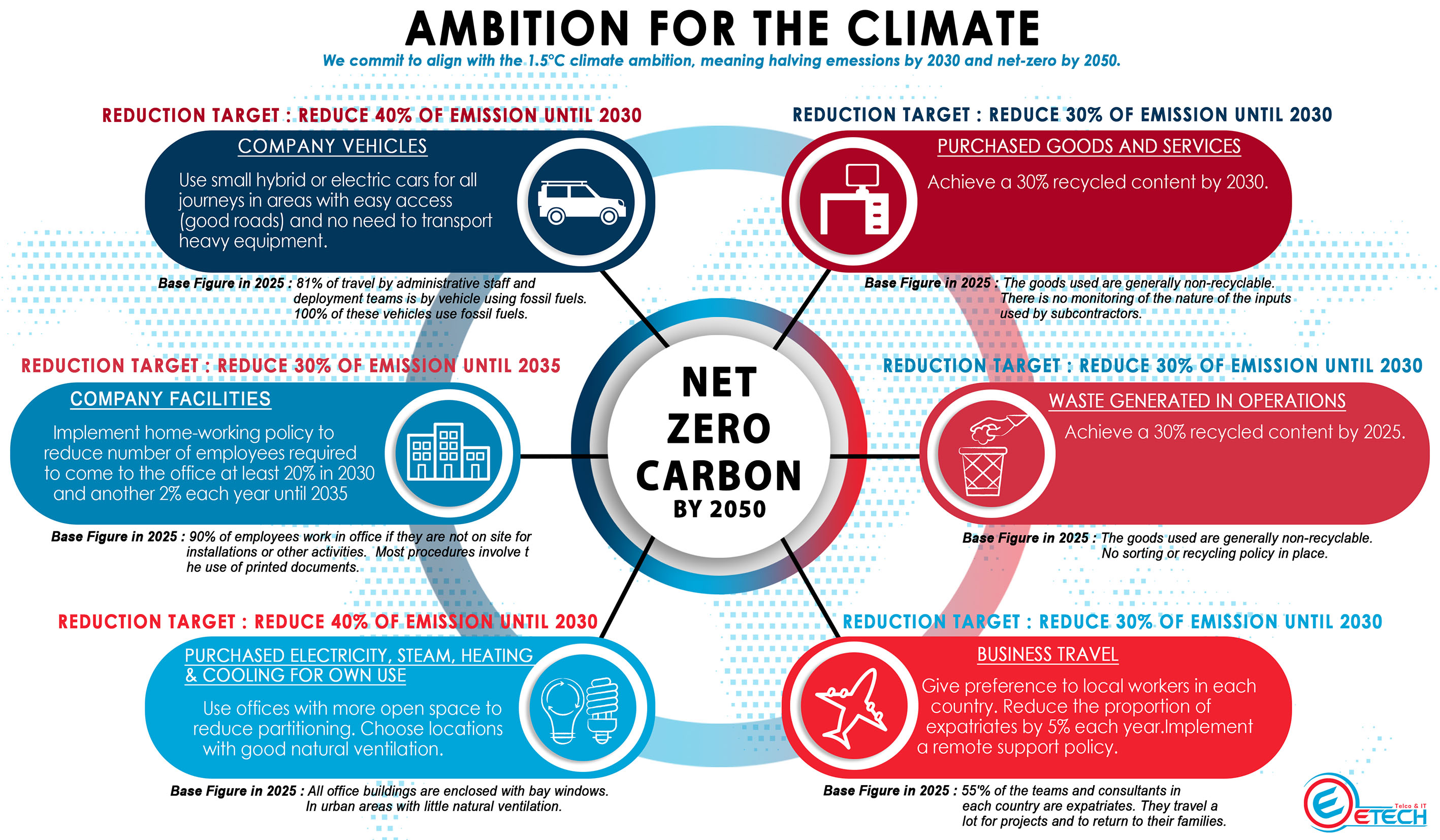Environmental Commitment
To offer our customers quality products and services with a low environmental impact and to demonstrate our commitment to reducing our own impact![]() By offering sustainable and innovative solutions for greater efficiency
By offering sustainable and innovative solutions for greater efficiency![]() By protecting the environment
By protecting the environment![]() By reducing our environmental footprint
By reducing our environmental footprint
OUR CLIMATE COMMITMENTS: NET ZERO CARBON BY 2050
Our commitment to the 1.5°C climate ambition, which means halving emissions by 2030 and achieving net zero by 2050.

Net Zero Carbon by 2040: a global commitment
To be Net Zero Carbon by 2040, we are committed to three pillars: reducing our own CO2 emissions, reducing our indirect emissions linked to our energy consumption and finally reducing our emissions generated upstream by our suppliers and downstream by our customers.
These three commitments correspond to scopes 1, 2, and 3 of the Greenhouse Gas Protocol, for which we have defined a 2025 roadmap validated by the SBTi (Science Based Targets Initiative), an international scientific benchmark for assessing companies' climate objectives.
To achieve this, we have defined an ambitious roadmap that sets milestones to be achieved by 2025, with targets in energy efficiency, renewable energy, the circular economy, carbon sequestration, and more, across all our activities.
Achieving energy sobriety
Company Vehicles : Reduce 40% of emission until 2030
81% of travel by administrative staff and deployment teams is by vehicle using fossil fuels. 100% of these vehicles use fossil fuels.
Use small hybrid or electric cars for all journeys in areas with easy access (good roads) and no need to transport heavy equipment.
Establish a replacement program for office pool cars and carry out an annual assessment of these investments.
Company Facilities : Reduce 30% of emission until 2035
90% of employees work in office if they are not on site for installations or other activities. Most procedures involve the use of printed documents.
Implement home-working policy to reduce number of employees required to come to the office at least 20% in 2030 and another 2% each year until 2035
Track the progressive reduction of employees' time in the office on the attendance file.
Purchased electricity, steam, heating & cooling for own use : Reduce 40% of emission until 2030
All office buildings are enclosed with bay windows. In urban areas with little natural ventilation.
Use offices with more open space to reduce partitioning. Choose locations with good natural ventilation. Implement home-working policy to reduce number of employees required to come to the office at least 40% in 2030.
Track the progressive reduction of energy spend (electricity, steam, heating & cooling for office use)
Purchased goods and services : Reduce 30% of emission until 2030
The goods used are generally non-recyclable.
There is no monitoring of the nature of the inputs used by subcontractors.
Achieve a 30% recycled content by 2030.
Track goods and services, ensuring the increase in recyclable goods is in line with targets.
Maintain a register of goods life cycle controls.
Capital goods : Reduce 30% of emission until 2030
The goods used are generally non-recyclable.
Achieve a 30% recycled content by 2030.
Track goods and services, ensuring the increase in recyclable goods is in line with targets.
Maintain a register of goods life cycle controls.
Waste generated in operations : Reduce 30% of emission until 2030
The goods used are generally non-recyclable.
No sorting or recycling policy in place.
Achieve a 30% recycled content by 2025.
Track goods and services, ensuring the increase in recyclable goods is in line with targets.
Maintain a register of goods life cycle controls.
Business travel : Reduce 30% of emission until 2030

55% of the teams and consultants in each country are expatriates.
They travel a lot for projects and to return to their families.
Give preference to local workers in each country.
Reduce the proportion of expatriates by 5% each year. Implement a remote support policy.
Monitor progress with the human resources department.
Processing of sold products : Reduce 40% of emission until 2030
The goods used are generally non-recyclable.
There is no monitoring of the nature of the inputs used by subcontractors.
Achieve a 40% recycled content by 2025.
Track goods and services, ensuring the increase in recyclable goods is in line with targets.
Maintain a register of goods life cycle controls.

